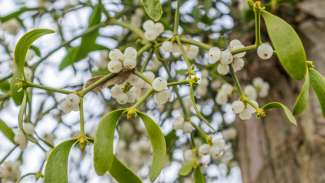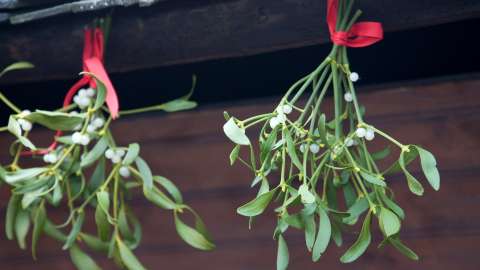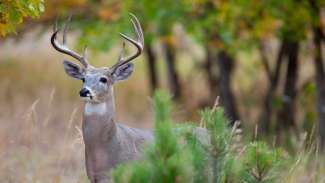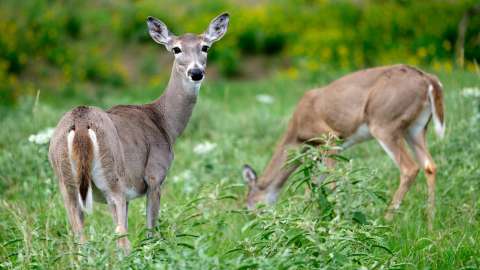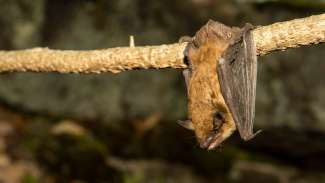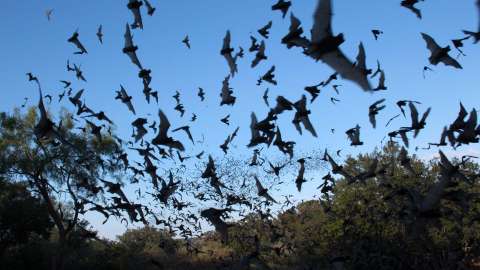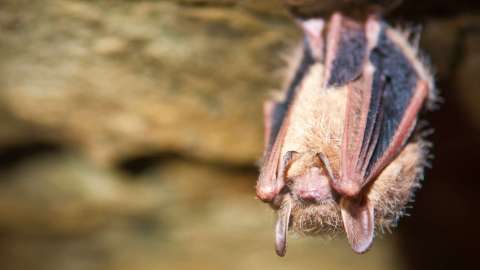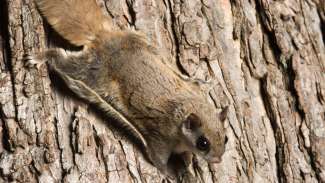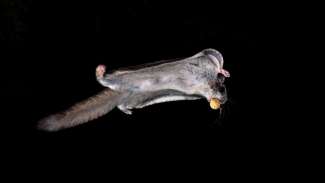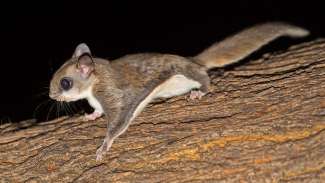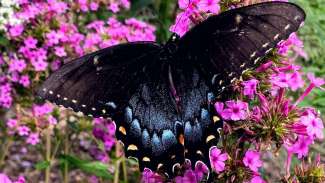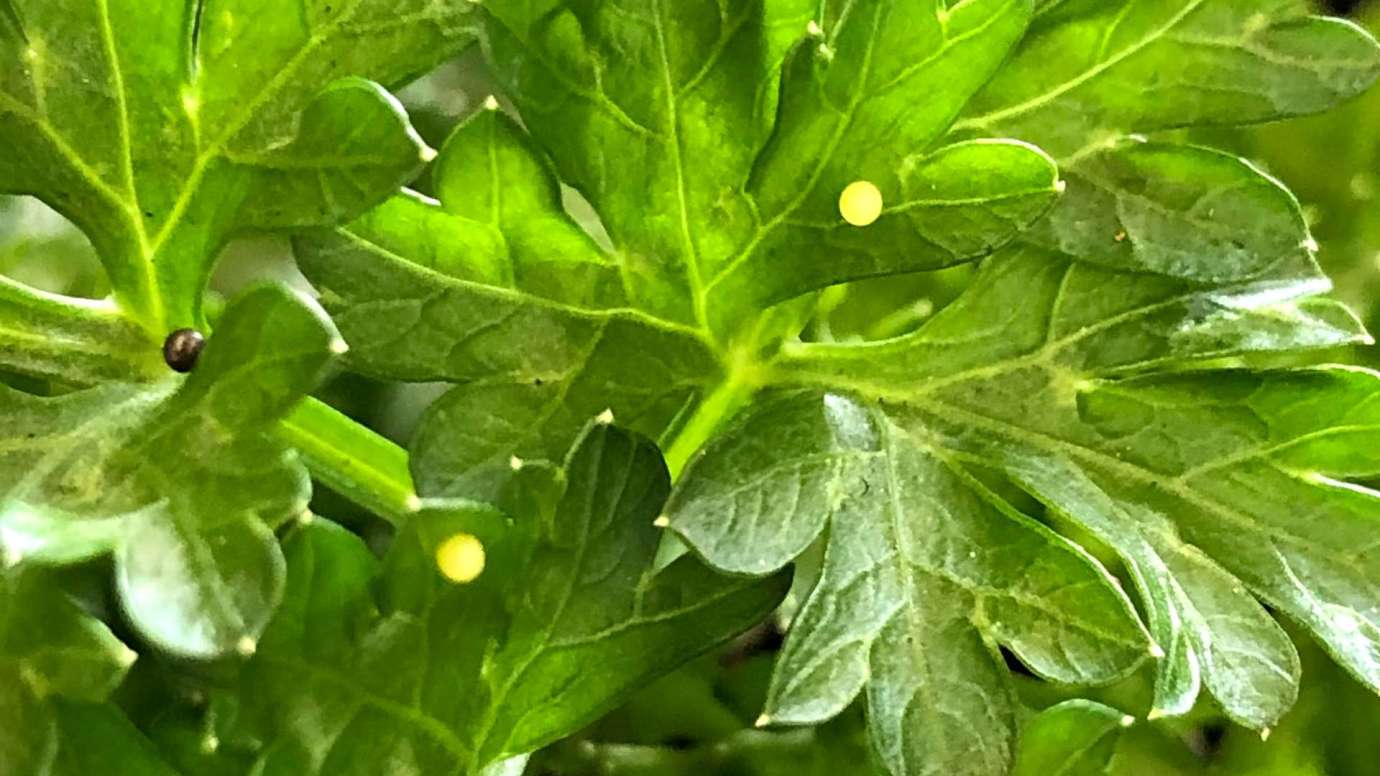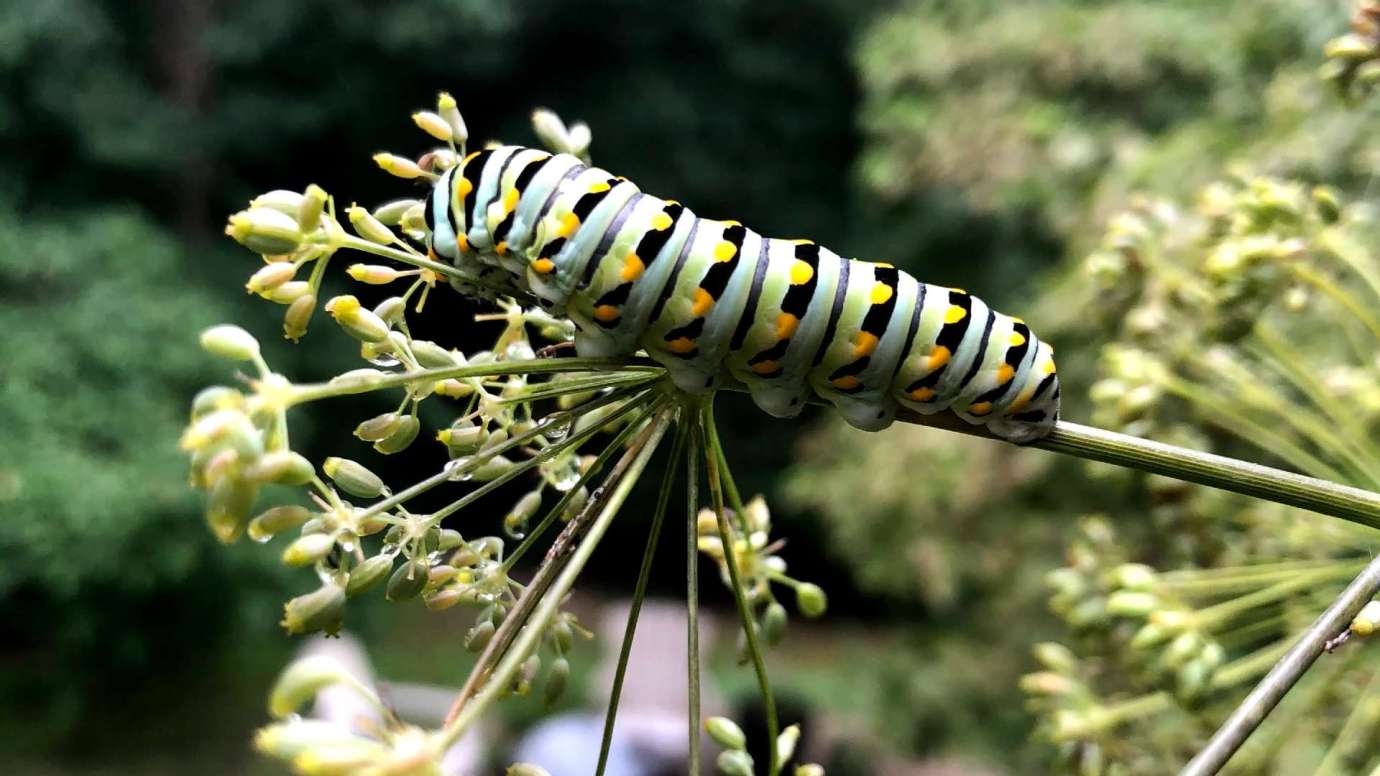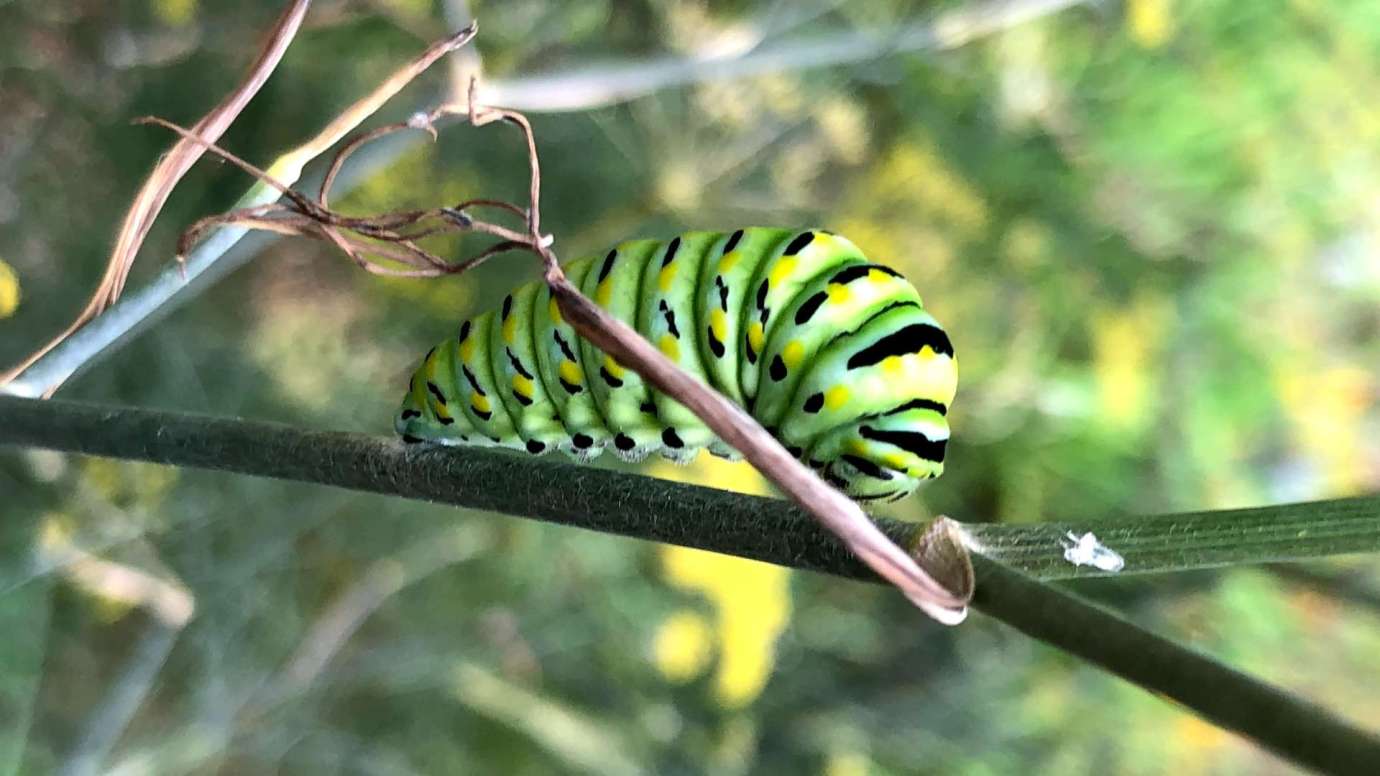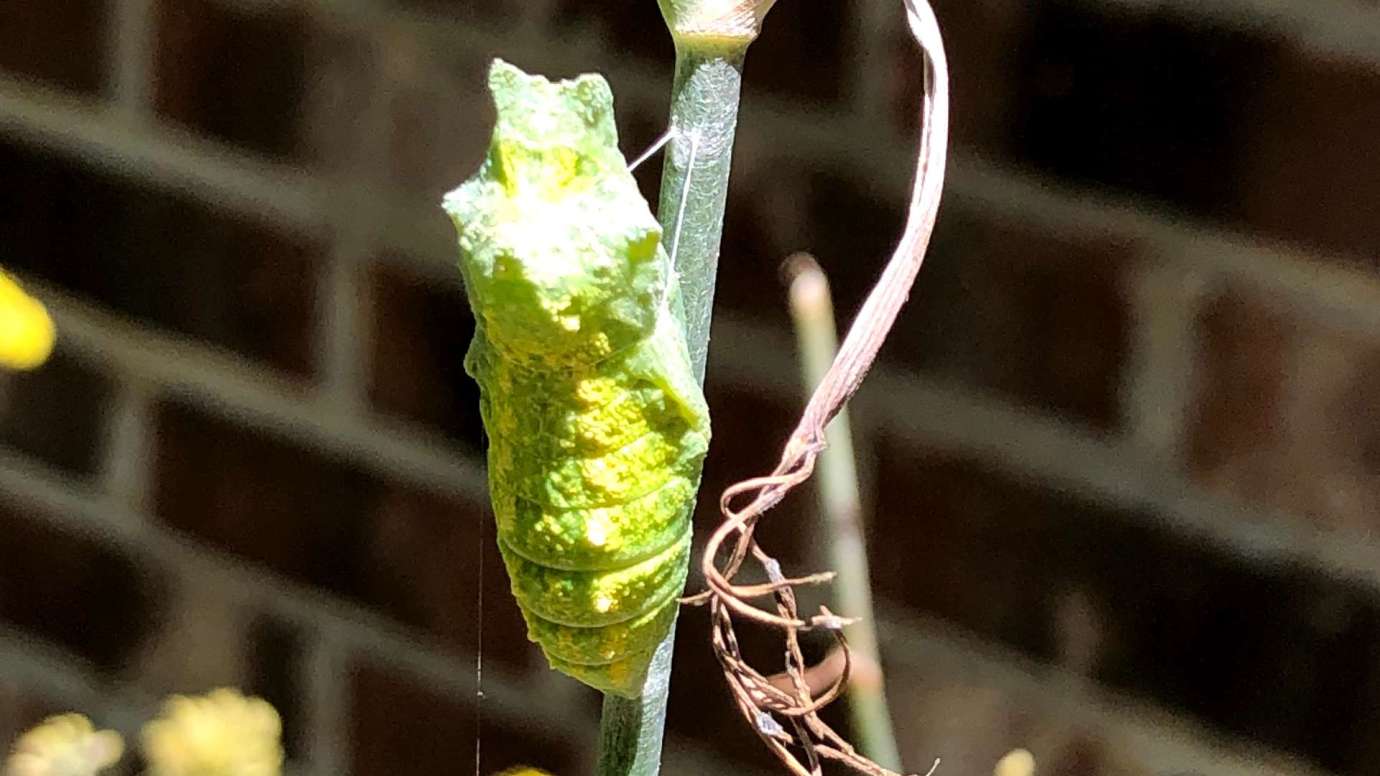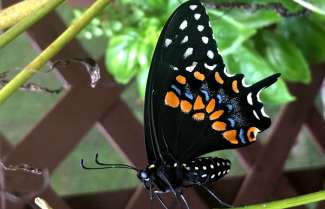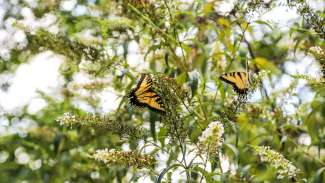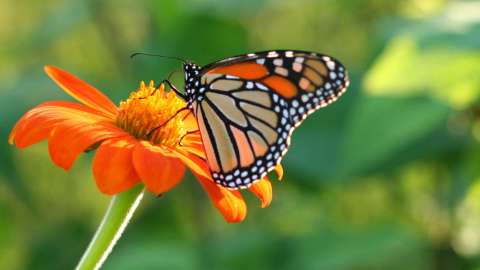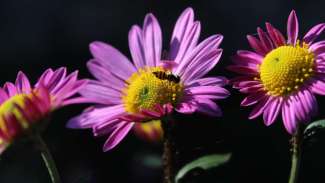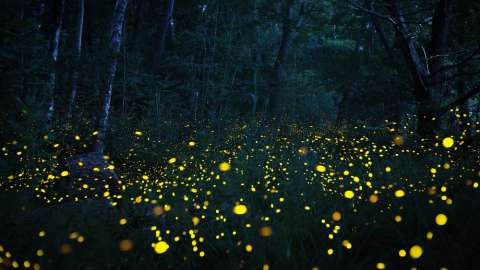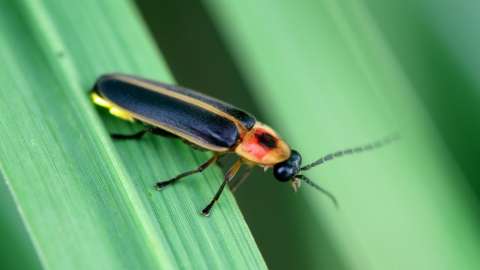Jump To:
Mistletoe
December brings us chilly days and colder nights, a winter’s solstice when the length of day and of the night are equal, and an opportunity to watch nature during a period of refresh. Without leaves on most of our trees (our lovely evergreen holly and pine trees remain fully leafed out all year long), it is easier to spot critters that may be using trees to nest in, perch on, or feed in. It is also a great opportunity to notice that some trees have these tangles of green leaves and white clusters of berries – sometimes small but at times grown to tangles so large it could be a veritable apartment for many small birds! What is this green tangle growing high up in our deciduous trees (those trees that lose their leaves in autumn such as our oaks)? Mistletoe!
Mistletoe is more than a small bouquet tied up in ribbons and hung in door frames at Christmastime, where traditions allow for kisses to be secreted quietly like a good luck token. Mistletoe is a hemiparasite plant that attaches to and drains the life out of living trees! Sounds festive, doesn’t it? Hemiparasitic plants are those that have the ability to produce some energy on their own, through the green chlorophyll and photosynthesis but rely on a host plant to produce the majority of its energy (which it steals). In the case of mistletoe, there are over 1,300 species of this plant worldwide, with close to 30 species in the continental United States and Canada alone. Here, in the United States, the most common type of mistletoe is in the Pharodendron genus, a Latin word that translates to “tree thief.” Regardless of the species, mistletoe is parasitic, it grows a root-like structure right into and under the bark of a tree, reaching into the cambium layer which allows the mistletoe to absorb nutrients and water that the tree is transporting through its branches and limbs. When small in size and quantity, this parasite is not deadly to a healthy tree, but if allowed to grow large and expand across the canopy of the tree, it will likely weaken the tree enough to kill it. While a tree dying seems like a terrible thing to many, it is important to remember that mistletoe and its processes are a native and natural part of our ecosystem. Scientists believe that the role mistletoe plays in our native landscape is important to the overall health of the forest: removing older, weakened trees, which – once dead – provide a place for birds to land and roost on, and for some birds and mammals to nest inside.
Mistletoe has been mentioned in the literature, songs, and even mythology across cultures and continents. It is often used as a symbol of renewal because of its evergreen leaves. One tale in Norse mythology sets a scene where Loki tricks the blind god Hodur into shooting his brother Balder with an arrow made of mistletoe, the only plant that could kill such a grand god. Other mythology and tales have had beliefs that mistletoe can cure infertility, and it was even part of Celtic Druid ceremonies many centuries ago. The first Christian reference to mistletoe links it to protection from witches and demons. As early as 1820 in English literature, Washington Irving, the author of Sleepy Hollow, referenced the tradition of couples kissing under the mistletoe. The serving class in Victorian England is credited with perpetuating this tradition around the Christmas holidays when mistletoe is easier to see and harvest from leafless trees. Traditions explain that a woman seen underneath mistletoe must accept a kiss from a doting gentleman, or risk bad luck. With each kiss under the mistletoe, one of the plant’s white berries must be removed until all the berries are gone, and therefore the luck, so the kissing must come to an end.
For all its traditions and folklore, it is important to note that mistletoe, across its distribution, is toxic to people. The white berries and the leaves produce a toxin that can cause blurred vision, diarrhea, nausea and vomiting, and in some cases seizures, hypertension, and cardiac arrest. These side effects are more pronounced in small children and house pets. In some countries, including parts of Asia and Europe, mistletoe continues to be researched and in some cases, medicines are produced from the plant, though some of the evidence in its use for treatment is largely inconclusive.
If you’re wondering just how mistletoe gets to the tops of those trees, look out for birds. The very same white berries which can be dangerous to people are an important food source to songbirds. Mistletoe, however, has evolved a clever trick to keeping its seeds from falling to the ground after the berries are eaten by birds. Each seed is coated with a substance called viscin which is very sticky. When a bird eats the berries the seeds often get stuck to the beak, which the bird then cleans by wiping it on the bark of the tree. Once on the bark, the seeds can start to grow their root-like structure called the haustorium, which penetrates the bark and reaches into the tree for the nutrients it needs to survive. This specialized form of parasitism is clever, but not unique to just mistletoe; vascular plants (most land plants including flowering plants, ferns, and trees) have evolved a type of parasitism at least 12 different times over the course of millennia, and mistletoe is just one seasonally relevant example.
If you are eager to see mistletoe in its natural setting, you are in luck. Oak trees, which are a common host tree to mistletoe in North Carolina, are abundant in Raleigh. Now that the leaves have mostly fallen off the trees, look high up into the canopy of trees like our oaks, maples, or walnuts, and look for a tangle of green twigs and branches. Oftentimes trees planted along roadsides, like those near the state capital, will be a convenient example of mistletoe and a surviving tree host. Many of our city’s nature preserves, parks, and community centers have trees with a variety of sizes of mistletoe and we encourage you to explore them in search of this interesting plant! Look on sidewalks after an especially windy rain event, or blustery day, sometimes small pieces of mistletoe will fall from the tree if it gets knocked down by the weather. While mistletoe is dangerous to eat, it is perfectly safe to touch and pick up, and even make a bouquet for your seasonal traditions. And the next time you sneak a kiss under the mistletoe, perhaps you will remember its long history of folktales and curiously parasitic lifestyle.
Oh Deer!
November is a great time to reflect on the changes in the season and begin preparations for a new year of growth. The leaves have dwindled on the trees, the days and nights are crisp, and the wildlife around us prepares for their winter habits. One of our larger wild neighbors, deer, becomes much more active and conspicuous in the late fall (October and November), as the temperature and changing food sources lead to seasonal biological changes in their behaviors. North Carolina is home to close to 1 million white-tailed deer, our second-largest land mammal in the state. With a tan-brown to gray fur color, showcasing distinct white patches around their eyes, nose, under their chins, and the inside of their legs, the flashing white underside of their short tails gives them their distinct name.
White-tailed deer are native to North, Central, and South America, with close to 30 or 40 subspecies depending on how experts define the subspecies. In the 1900s, North Carolina had about 10,000 animals being hunted to alarmingly small population sizes. Thanks to recovery efforts between the 1940s and the 1970’s we have a healthy population of white-tailed deer across North Carolina and across most of the United States (with exceptions for areas in Arizona, California, and Utah where they are displaced by another species of deer, the Mule deer). White-tailed deer are considered even-toed ungulates, meaning they have two toes on each foot- made up of a fingernail-like material called keratin which becomes a hardened hoof, and they have a multi-chambered stomach, like cows. Closely related to other ungulates, like cows and antelope, deer are found in every continent of the world except Antarctica and Australia, in a variety of sizes and different habitats. Like cows, the multi-chambered stomach allows deer to eat many items that cannot be digested by human stomachs, including many grasses, acorns, mushrooms, and even poison ivy.
White-tailed deer are well-adapted to living in low-light conditions and are most active at dusk and dawn, when many natural predators may be less active, and when daylight is low. They can thrive in these conditions because of their horizontally slit pupils (the opposite of cats, which have vertically slit pupils) and dichromatic vision, which sees mostly in blues and yellows but lacks green/red receptivity. Thanks to their large ears, their hearing is much better than our human hearing, and able to detect noises in their surroundings- one way they can avoid predators and other dangers. These large ears also help them hear one another; deer have a surprisingly large array of vocalizations and noises and can even distinguish individuals by their sounds! Mother deer can recognize their young, hidden in tall grasses, by their sounds and smell alone.
Here in North Carolina, white-tailed deer may live in various habitats and survive all over the state, from the mountain to the coast. Locally, these large mammals in Raleigh have become accustomed to living among humans, grazing on lush landscaping plants, grasses, and the abundance of acorns that the City of Oaks provides. With fewer leaves on trees and shrubs during the fall, the deer can be seen more quickly. But fall is also a busy time for deer, so it is critical to be extra vigilant when driving at dawn at dusk, as deer do not heed traffic laws. Around late October to late November, male deer will begin to compete for the attention of female deer to reproduce. This period in time is called “the Rut,” and when males enter into combat with one another, it is called “rutting.” During the rut, male deer will use the antlers they have grown all summer long as a way to silently communicate with females that they are a physically fit and healthy male- the larger their antlers, the more fit the deer, because growing antlers requires the ability to eat more protein and calcium than normal, and because large antlers are heavy and need a strong male to carry them around. Antlers are also used as a tool for engaging in feats of strength between males, as two large males will wrestle one another with their antlers to determine who gets the right to breed with females in the area. Male deer, also called bucks, become so focused on breeding during this period that they neglect to rest and even eat. Their distraction can lead them to more easily venture into the middle of roads and ignore the dangers of human civilization.
Following the rut, deer will relax into the winter months. Female deer, called does, will spend as much time as possible eating high-quality foods when they find them. Protein and calcium are crucial if they are pregnant. Females will generally stay in small groups together throughout the winter, finding safety and warmth in numbers. Any offspring, or fawns, from earlier this summer, will remain with their mother, although usually fully weaned before the rut begins, forming a lost family unit. Young males not yet of breeding age can stay near their mother but are also known to venture off on their own when large enough, finding other young, immature males who are not yet breeding, somewhat akin to a bachelor group. In the late spring, those produced during the rut will give birth to one, two, or sometimes (more rarely) three fawns. Fawns are born with reddish-brown fur covered in many white spots that dapple all over their backs. For the first month of their life, a fawn will hide in tall vegetation, like prairie grasses and thickets, near their mothers who nurse their young five or more times a day. After this first month, fawns can join their mothers in short adventures in foraging, learning to eat solid foods like grasses and young plants.
For those simply enjoying the beauty of the trails and greenways around Raleigh, this time of year is an excellent opportunity to spy deer in their more active time while being vigilant about our large (and distracted) neighbors. If you spot a deer on a trail, give it space, do not approach it, and do not allow your pets to chase after it. While often a spooked deer will instinctively flee from danger (humans and our pets), deer in rut can be unpredictable in their reaction. They may choose to stand their ground instead of running away- a situation that can be dangerous when a large buck weighing between 150-300lbs decides it is not afraid of us. Watching deer from a safe distance can be quite a spectacular experience, especially this time of year. We want to remember we share our natural spaces with some incredible wildlife. Being a good neighbor to these majestic animals is one way to continue to respect our natural areas. If you do happen to encounter a deer or two on your adventures around Raleigh’s parks and natural spaces, let us know! We love hearing about the beautiful things people see when they are in our natural areas.
Bats in October
October in North Carolina brings cooler weather, falling leaves, and shorter days! With all the signs and symbols of fall, it is a great time to celebrate an often-misrepresented critter of the night: bats. Bats live relatively secretive lives, being most active right after dusk and right before dawn. They have some unusual habits, like hanging upside down and residing in caves or hollow trees, so it is easy to see why they are misunderstood. The reality is that these creatures of the night are essential parts of our environment.
Bats are mammals, which means they have fur, three ear bones in each ear, and lactate or feed their young milk. Bats are the only truly flighted mammals able to flap their wings, unlike flying squirrels that only glide through the air. Bats live in almost all parts of the world, spanning across most continents and living everywhere except extreme deserts and the polar regions. Over 1,400 species of bats and the smallest, Kitti’s hog-nosed bat (also known as the bumblebee bat), weighs less than a penny! Larger and more well-known bat species include the fruit-eating Flying Foxes found in countries around the southern pacific regions of Asia, with a wingspan over 6-feet wide. Here in the United States and Canada, there are about 45 species of bats, and in North Carolina, we have recorded 17 different species calling our state home. The U.S Fish and Wildlife Services has 13 of the United States’ bat species listed as Endangered, with population numbers so low there is a concern the species will disappear forever- which can be a big problem for ecosystems and people.
Bats are beneficial animals to have around our natural areas. In North Carolina, all species of bats are insectivores, which means they eat flying insects. Many will eat moths, beetles, dragonflies, caddisflies, and most will eat thousands and thousands of mosquitoes and other flies. Because bats eat at least their body weight in food each night, these insect-loving animals provide all-natural insect control, which helps farmers, foresters, and everyday people who do not want clouds of mosquitoes around. On a global scale, many bat species rely on fruit and nectar, and a small selection feast on larger prey, including frogs and, infamously, blood from animals like livestock. So if you enjoy eating mangos, avocados, or bananas, it is time to send a quiet thank you to bats - without their pollinating activity, we would not have these fruits or vegetables. The ubiquitous Halloween chocolates would also not be here without bats spreading the seeds of the cacao plant, resulting in future cacao trees (which produce the main ingredient in chocolates we love to eat). Beyond our foods, bats are also known to pollinate and help produce close to 80 different plants used for human medicinal purposes.
Why are bats so feared with such vital roles in the environment as crucial pollinators and built-in insect control? Perhaps it is because they are so little understood. Bats spend most of their waking hours when we are sleeping. As specialized night-time hunters, bats catch prey as they fly through the sky; the fastest recorded flight was close to 100 miles per hour from a Mexican Free-tailed Bat. Bats' wings are not like those of birds but serve similar purposes. While birds use feathers to aid in flight, bats’ wings are like the bones of a modified human hand and are covered with a very thin layer of skin (and fur) over the “fingers.” They fly nearly silently and use echolocation to detect both their prey and their surroundings. Myths tell us bats are blind, but they have decent eyesight, although their eyes are not used for navigating or hunting. Bats create sounds, like short, quick, high-pitched tongue clicks, which bounce off items in the environment and make their way back to the bat’s ears. Some species use higher-pitched sounds to detect small insects they are hunting while using lower-pitched sounds to detect objects in the flight path they need to avoid (like a tree or a branch). Bats are not the only animal to echolocate. Marine mammals like whales and dolphins also use this technique. Humans have studied this technique to try and produce technology that can help people who have vision loss navigate the world around them.
Other myths that surround bats are that they are flying rodents. While rodents are also a type of mammal, the two groups are not very similar at all. Bats are specialized mammals designed to hang upside down (their knees are entirely backward to ours) and fly independently. Bats are not antisocial or vicious animals, although they are often portrayed as scary. Bats are very socially advanced, having social systems similar to those of higher primates (like Chimpanzees), elephants, and dolphins. Bats share information and food and will even adopt an orphaned young (called a pup). Studies have shown bats to be brilliant animals that learn quickly and remember what they learned; one study showed a species of frog-eating bat could understand the song of a species of frog within minutes and retained that knowledge for up to two years! Mexican Free-tailed bats are so social they live in large colonies and have been shown to recognize the sound or smell of their pup among over 300 other pups in the same area. Living in such large colonies, bats spend a great deal of their time grooming and keeping themselves (and others they live with) clean and parasite-free.
And because Halloween is around the corner: what’s the connection between vampires and bats? While there are species of bats called vampire bats, they are only found in mainland South America, and folklore of vampires predates the knowledge that vampire bats even existed. Stories and tales surrounding vampires and vampire-like mythical creatures began in Eastern Europe in the 16th and 17th centuries. Stories of vampire-like lore can be found in cultures across continents, with creatures such as the Ramanya from the Betsileo people of Madagascar, the Cihuateteo of the Aztec culture, and the Mandurugo of the Tagalog culture in the Philippines. Even early American folklore had tales of vampire-like occurrences likely linked to deaths from Tuberculosis (then known as “consumption”) in late 18th century New England. Historically, the word “Vampire” (or its equivalent) was found in the English language about half a century before it was seen in zoological texts describing the bat species that drink blood from livestock as a food source.
Here in Raleigh, we have several species of bats that spend time in old hollow trees, underground caves, or other small crevices. They provide us with a great insect control service and are essential to the health of our natural areas. Unfortunately for the bats, populations continue to decline due to habitat loss (fewer natural places to roost or sleep in during the day). Bats across the United States also suffer from a relatively recent but deadly disease called White Nose Syndrome. This fungal infection affects the noses and wings of bats trying to hibernate during the winter. Luckily, there are some things we can do to help. Building and placing wooden bat boxes that act as a place for bats to roost during the day is a great project that will help many different species of bats locally. Planting native plants that attract our native insects will provide our native bats with ample food sources as well. If you have a dead tree in your yard that is not posing a threat to your property, consider leaving it up instead of taking it down - birds and mammals will all take advantage of this natural hiding space and shelter. If you are curious about the bats in our area, visit one of our local nature parks and ask about bats that live around the park. Finally, remember to leave bats in the wild. While they provide many great services, they are wild animals and should never be touched or handled as they can carry rabies, transmissible to humans and pets. If you ever encounter a wild bat in your home, call animal control and ask for an agent to help you instead of trying to do it yourself – this will keep you and the bats safe.
Flying Squirrels
Did you know that North Carolina is home to six species of squirrels? Although we in the Raleigh area most often see our familiar Eastern Gray Squirrel, we actually have four of the six squirrel species here. Depending on where you are, folks in Raleigh can spot the Eastern Gray Squirrel (Sciurus carolinensis), Eastern Chipmunk (Tamias striatus striatus), Groundhogs (Marmota monax), or the Southern Flying Squirrel (Glaucomys volans). The state’s other two squirrel species, the Fox Squirrel (Sciurus niger) and the American Red Squirrel (Tamiasciurus hudsonicus), have smaller, restricted ranges in our state, either in the sandhills region (about an hour south and east of Raleigh) or in high elevation forests (such as near Boone), respectively. Each species of squirrel is unique in its preferred habitats, diets, and behavior.
Because the Southern Flying Squirrel is nocturnal and is the smallest squirrel species in the state, it is often referred to as the most common mammal that humans never see. At 8.5-9.5 inches long (including its tail), these tiny squirrels are elusive at best, but if you know where and how to look, you may notice signs that they are around. Southern Flying Squirrels can be found throughout North Carolina, living high in the trees of hardwood and mixed pine-hardwood forests where they will nest inside cavities or holes in the trees (which, you maybe can imagine, hard-working woodpeckers do not always appreciate). Unlike other squirrel species in the state, the Southern Flying Squirrel is almost exclusively arboreal, meaning they spend most of their time up in the trees. While their name implies that they have the ability to fly, they actually glide. Instead of the wings that flighted birds and bats have, flying squirrels use a specialized flap of skin, or membrane, called a patagium, which stretches from its wrists to its ankles and billows with air the way a parachute works for skydivers. By changing the angle and tension of this membrane, a flying squirrel can direct how it glides through the air and between trees. In fact, you could say flying squirrels have truly mastered the technique of gliding through the air as a way of travel, scampering up a tree before jumping out and heading towards the next tree. The longest ever recorded glide from a flying squirrel was measured at 200 feet long!
But why spend so much time and energy just gliding about? While we may think it's just for fun, the squirrel’s gliding is one way for them to reach their food source or their home. These squirrels are omnivores, like most people, meaning they eat plants and animal protein (meat). These squirrels often eat seeds, nuts, fungi, fruit, and insects, but Southern Flying Squirrels have the most meat-eating diet of any squirrel species in the state. Southern Flying Squirrels supplement their diet with eggs, small birds, and even freshly dead animal meat. The diversity in their diet allows this species to survive and thrive in many different habitat types from the mountains to the coast in our state. When not gliding around searching for its next meal, a flying squirrel may be searching for a cavity in a tree or going back to its own nest to cart for young.
With our seasons changing and temperatures dropping at night, these squirrels may begin to roost together in those tree cavities. Although typically gatherings of squirrels are small in numbers, one group was measured at 50 individuals in one cavity! The flying squirrels will build nests inside hardwood trees, such as oak, providing a cavity for nesting and nuts as food. The squirrels will use chewed-up bark, grasses, lichens, mosses, or even feathers to line the cavities and create a soft bed. In a cozy, protected cavity, these soft beds serve as an ideal home in which to have and raise young. A mother flying squirrel can give birth to up to six (6) babies at a time, although typically they have two or three young at a time. Mothers can have two litters of young each year, once in January or February and again in June or July. At birth, a Southern Flying Squirrel weighs less than an ounce or about one AA battery! Young squirrels are cared for by their mother until she has her next litter of babies. By the time a young squirrel is eight weeks old, it can glide between trees and search for some snacks of its own.
While you may not have known this species of squirrel even existed, there is a good chance you have been around at least one of them if you have spent some time living in North Carolina. Secretive, active at night, quick and small, these squirrels are easier to detect through the signs they leave behind. These squirrels will readily set up residence in a bird's nest box if convenient to a tree that has food for them. Look for a nest made of bark, moss, feathers, lichen, or fur, and not cup-shaped like many birds will make. Listen for a bird-like chirping in the early evenings or before dawn, which may be a flying squirrel vocalizing to others. Look for acorns that have been chewed near the top and opened as though with a can opener made of tiny teeth. And if you suspect that these cute, harmless rodents may have discovered a great big cavity in the shape of your attic, call a wildlife removal agency to help remove them humanely. And the next time you see one of the other squirrel species, maybe look up in a tree and send a silent “hello” to the squirrels you aren’t seeing, living secretly among us high up in the trees.
Meet the Black Swallowtail Butterfly
As summer winds down and the days are shorter but still sunny and hot, there is a large, black-winged insect frequently seen visiting gardens. What is that big, beautiful creature? The Black Swallowtail butterfly, one of our most beautiful and fascinating native insects.
The Black Swallowtail, like all butterflies, lays its eggs on a specific host plant. The female butterfly lays her eggs on parsley, dill, carrot, or Queen Anne’s Lace, all common garden plants. The eggs look like tiny golden orbs, perfectly spherical and laid on top of the plant, making them easy to spot. In three to five days, tiny caterpillars hatch and begin to eat the leaves.
The next ten to fourteen days, the caterpillars are exciting to observe! The caterpillars are in the larva stage. They will go through 5 stages called instars as they grow and change drastically in this short time. In the 1st instar, the caterpillars are only 2 mm long and black with a white “saddle.” They resemble bird droppings to camouflage from predators. Next, the caterpillars molt by shedding their exoskeleton to reveal a new look. They are a bit larger in the 2nd and 3rd instars but similar in appearance. The 4th instar looks like a totally different caterpillar, striped with black, white, and orange. The 5th instar brings more dramatic change as they are now 4 cm long and striped with yellow, green, and black. They also have a new defense- orange “horns’ that pop out when the caterpillar is disturbed!
After the 5th instar, the caterpillars will begin to slow down their movements and form a curved shape, attaching themselves to a nearby plant stem by their last segment and with a strong strand of silk around their upper body. Finally, the final molt occurs, and the caterpillar is now in the pupa stage, called a chrysalis. The chrysalis can range from bright green to brown to blend in with the plant. In 8-12 days, the chrysalis will begin to turn black as the exoskeleton becomes translucent, showing the black butterfly within. Then the dramatic black, blue, yellow, and orange butterfly emerges and dries its wings in the sun before flying off to begin the life cycle again!
The black swallowtail butterfly life cycle is easy to observe at home and in parks like Durant Nature Preserve, a wonderful insect garden. Anywhere the host plants are growing, the Black Swallowtail can be seen in its different stages- sometimes all on the same host plant at once! At home, a host plant can be covered with netting or kept in a screened butterfly container to keep hungry predators away. Raising this butterfly and releasing it or observing its life stages in the garden is an engaging activity for children and adults!
Summer Pollinators
For many, summertime is a time for gardening or, at the very least, a time to find fresh, locally grown, fruits and vegetables. Whether a tomato or a bushel of fresh blueberries, North Carolina summers are a great season for tasty and fresh produce. Many of the fruits and vegetables we grow and love to eat would not be possible without native pollinators.
A pollinator is anything that helps carry pollen from the male part of the flower to the female part of the flower. In doing so, a pollinator allows for plants to be fertilized and grow seeds in the form of fruits or vegetables. Likely the most recognized pollinator is the European Honeybee. Although this is where most of our honey comes from, this species of bee is not originally from North Carolina or even the United States. While the honeybee is extremely beneficial to our farms and crops, it is important to also consider and celebrate the large diversity of native pollinators as well.
North Carolina is home to over 500 species of native pollinating bees, butterflies, and birds. The one species of hummingbird native to North Carolina, the Ruby-throated Hummingbird, is known to be a great pollinator, often seen around flower gardens with plants like Obedient Plant (Physostegia virginiana), Trumpet Creeper (Campsis radicans), or Coral Honeysuckle (Lonicera sempervirens). Pollinators are important to more than flower gardens – more than 100 of North Carolina’s native pollinator species are considered to be vitally important to the state’s agriculture through their interactions with flowering crops like blueberries and apples.
Pollinators are often misunderstood or poorly understood. Some pollinators are not well studied, and scientists do not know much about them, including several species of small flies, beetles, some wasps, and ants. Although generally very small, some of these pollinators can have a very big impact on our lives. The state’s tourism industry relies on small pollinators, like syrphid flies, which are key pollinators for wildflowers like lilies, azaleas, or native orchids like lady’s slippers. Other pollinators are feared and misunderstood- with ideas that all flying buzzing things are aggressive stinging insects. While several pollinators do have stingers and can have a painful sting if aggravated, most of our pollinators are non-territorial, solitary, and small.
In North Carolina, most of our native pollinators are solitary bees, small individuals who nest in small cavities in the ground or in hollow stems or reeds in secluded, quiet areas that are undisturbed. Both the leafcutter bee and the mason bee are common pollinators that can be found statewide. Both of these pollinators will use the pollen they collect from flowers as a source of food for their young. These bees create balls of pollen which they place inside a small chamber where they lay their eggs. Once the egg has hatched, the larval (baby) bee will feast on this high-protein pollen ball for several weeks, allowing it to grow and pupate inside a cocoon. The pupa of young bees will spend the winter in this chamber, surviving on the calories from that pollen ball, before it emerges as an adult in winter.
Not all our native pollinators spend their entire lives in North Carolina. One of our most notorious pollinators is a long-distance migrant – the monarch butterfly. Monarchs and other native butterflies and moths are crucial pollinators of native flowers, including our much-loved blueberries and plums. If you are a fan of pollinators like monarchs and would like to get a good look at some of them before cooler weather comes to stay for the fall and winter, August and September are ideal months to look for caterpillars, moths, and butterflies. Parks like the nature preserves in the City of Raleigh are filled with native pollinator plants that provide habitat for caterpillars (to eat and eat and eat) as well as flowering plants that provide food and nectar to adult butterflies. Many parks will offer programs this time of year about pollinators and how to grow gardens designed for wildlife. We hope that these will help you embrace the pollinators around you, while also helping the pollinators find great sources of food and even some homes.
Fireflies of the Season
The magic of summer is upon us and the long, warm nights are punctuated by the blinking light patterns of fireflies. Many who have grown up in North Carolina, or close by in other southern states, share fond memories of catching fireflies in jars to watch them blink “on” and “off” before releasing them to the open fields and forests where they live. Whether you wait with bated breath and look out for the very first fireflies of the season, or you are pleasantly surprised mid-summer when you notice these lightning bugs, fireflies consistently deliver a light show which is a summertime joy every year in North Carolina.
North Carolina is actually home to 30-40 different species of fireflies, which cover every region of the state. Fireflies aren’t flies at all – they are actually flying beetles; and their signature light show is known as bioluminescence, a word that describes the ability a living being has to produce light. Scientists have discovered examples of bioluminescence in a small variety of animals, most of which live in the ocean (such as fish, jellyfish, and crustaceans), although a few, like glow worms, fireflies, fungi, and bacteria live on land. Bioluminescence appears to have a few different purposes in nature, including camouflage, attracting prey, mimicking other creatures, warning potential predators away, startling defense against predators, and even communicating with and attracting others of the same species.
For the fireflies of North Carolina’s summers, communication and attracting mates seems to be a primary purpose, although evolution suggests the light show might have come about as a way to detract predators from making a snack out of these insects. Each firefly species has its own unique signaling system- a flashing light pattern that is used to attract a mate. In most cases, the males will flash the lights in their abdomens while females sit back and watch from nearby on the ground or in vegetation. If she thinks a male is doing a good job with his light display, she will flash her light back to the male. The male and female may signal their lights back and forth to each other, communicating interest and intent, ending up with a successful mating.
A common backyard species in North Carolina, known as the Big Dipper (Photinus pyralis) can be seen flying at dusk about 3 feet off the ground. The male’s light pattern is distinctly shaped like a “J”, flashing every 5 seconds. The female Big Dipper will respond about two seconds after the male, with a short half-second blink of light. But while the flashing lights are mostly used as a way to find mates, scientists believe the silent flashing signals to potential predators that fireflies are a foul-tasting snack. Think of this as the opposite of the bright lights of human fast-food restaurants, luring us in for a yummy treat; the bright coloration of a firefly’s light can work to detract others from feasting on these small beetles.
While most species of fireflies will flash independently of other individuals in their species, North Carolina is home to a rather famous species of synchronous fireflies, where all the males of the species flash at the exact same time. Seen in the Great Smoky Mountains National Park, the species Photinus carolinus can be seen as a magical display of thousands of tiny lights turning “on” and “off” at the same moment. This adaptation gives all the males an equal opportunity to find a mate. The displays of this species are so breathtaking that state and national parks where the species occurs have instated a lottery ticketing system to control the crowds that gather to observe this summer spectacle of lights.
Luckily for us, there are fireflies all across North Carolina and their beautiful summer light shows can be seen right here in Raleigh. Enjoy a warm evening sitting on a porch or visiting a local park and await the unmistakable flashes of summertime brought to us by small bioluminescent beetles!
